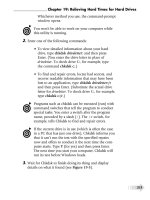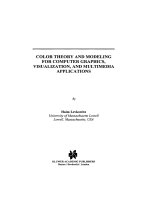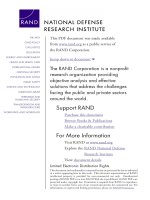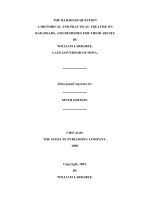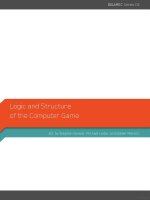Algorithm and Networking for Computer Game docx
Bạn đang xem bản rút gọn của tài liệu. Xem và tải ngay bản đầy đủ của tài liệu tại đây (2.81 MB, 289 trang )
Algorithms and Networking
for Computer Games
Algorithms and Networking
for Computer Games
Jouni Smed
Harri Hakonen
University of Turku, Finland
Copyright 2006 John Wiley & Sons Ltd, The Atrium, Southern Gate, Chichester,
West Sussex PO19 8SQ, England
Telephone (+44) 1243 779777
Email (for orders and customer service enquiries):
Visit our Home Page on www.wiley.com
All Rights Reserved. No part of this publication may be reproduced, stored in a retrieval system or transmitted
in any form or by any means, electronic, mechanical, photocopying, recording, scanning or otherwise, except
under the terms of the Copyright, Designs and Patents Act 1988 or under the terms of a licence issued by the
Copyright Licensing Agency Ltd, 90 Tottenham Court Road, London W1T 4LP, UK, without the permission in
writing of the Publisher. Requests to the Publisher should be addressed to the Permissions Department, John
Wiley & Sons Ltd, The Atrium, Southern Gate, Chichester, West Sussex PO19 8SQ, England, or emailed to
, or faxed to (+44) 1243 770620.
This publication is designed to provide accurate and authoritative information in regard to the subject matter
covered. It is sold on the understanding that the Publisher is not engaged in rendering professional services. If
professional advice or other expert assistance is required, the services of a competent professional should be
sought.
Other Wiley Editorial Offices
John Wiley & Sons Inc., 111 River Street, Hoboken, NJ 07030, USA
Jossey-Bass, 989 Market Street, San Francisco, CA 94103-1741, USA
Wiley-VCH Verlag GmbH, Boschstr. 12, D-69469 Weinheim, Germany
John Wiley & Sons Australia Ltd, 42 McDougall Street, Milton, Queensland 4064, Australia
John Wiley & Sons (Asia) Pte Ltd, 2 Clementi Loop #02-01, Jin Xing Distripark, Singapore 129809
John Wiley & Sons Canada Ltd, 22 Worcester Road, Etobicoke, Ontario, Canada M9W 1L1
Wiley also publishes its books in a variety of electronic formats. Some content that appears
in print may not be available in electronic books.
British Library Cataloguing in Publication Data
A catalogue record for this book is available from the British Library
ISBN-13: 978-0-047-01812-5
ISBN-10: 0-470-01812-7
Typeset in 10/12pt Times by Laserwords Private Limited, Chennai, India
Printed and bound in Great Britain by Antony Rowe Ltd, Chippenham, Wiltshire
This book is printed on acid-free paper responsibly manufactured from sustainable forestry
in which at least two trees are planted for each one used for paper production.
In memory of
Timo Kaukoranta
and
Timo Raita
Contents
List of Figures xi
List of Tables xv
List of Algorithms xvii
Preface xix
Acknowledgements xxi
1 Introduction 1
1.1 AnatomyofComputerGames 3
1.2 SyntheticPlayers 5
1.2.1 Humanness 6
1.2.2 Stance 6
1.3 Multi-playing . . . . . . . . . . . . . . . . . . . . . . . . . . . . . . . . . . 7
1.4 Games and Storytelling . . . . . . . . . . . . . . . . . . . . . . . . . . . . . 8
1.5 OtherGameDesignConsiderations 9
1.6 Outline of the Book . . . . . . . . . . . . . . . . . . . . . . . . . . . . . . 10
1.6.1 Algorithms 11
1.6.2 Networking 11
1.7 Summary 11
Exercises 12
I Algorithms 15
2 Random Numbers 17
2.1 Linear Congruential Method . . . . . . . . . . . . . . . . . . . . . . . . . . 18
2.1.1 Choiceofparameters 20
2.1.2 Testing the randomness . . . . . . . . . . . . . . . . . . . . . . . . 22
2.1.3 Usingthegenerators 24
2.2 DiscreteFiniteDistributions 25
2.3 Random Shuffling . . . . . . . . . . . . . . . . . . . . . . . . . . . . . . . . 27
2.4 CreatingGameWorlds 30
viii CONTENTS
2.4.1 Starmapgeneration 30
2.4.2 Terraingeneration 32
2.5 Summary 38
Exercises 41
3 Tournaments 47
3.1 RankAdjustmentTournaments 50
3.2 EliminationTournaments 53
3.3 ScoringTournaments 60
3.4 Summary 65
Exercises 69
4 Game Trees 73
4.1 Minimax 74
4.1.1 Analysis 77
4.1.2 Partialminimax 78
4.2 Alpha-BetaPruning 82
4.2.1 Analysis 84
4.2.2 Principalvariationsearch 86
4.3 GamesofChance 86
4.4 Summary 89
Exercises 91
5 Path Finding 97
5.1 DiscretizationoftheGameWorld 98
5.1.1 Grid 99
5.1.2 Navigationmesh 100
5.2 FindingtheMinimumPath 102
5.2.1 Evaluationfunction 103
5.2.2 Properties 104
5.2.3 AlgorithmA* 105
5.3 RealizingtheMovement 108
5.4 Summary 109
Exercises 110
6 Decision-making 115
6.1 Background . . . . . . . . . . . . . . . . . . . . . . . . . . . . . . . . . . . 115
6.1.1 Levelsofdecision-making 116
6.1.2 Modelled knowledge . . . . . . . . . . . . . . . . . . . . . . . . . . 117
6.1.3 Methods . . . . . . . . . . . . . . . . . . . . . . . . . . . . . . . . 119
6.2 FiniteStateMachines 122
6.2.1 ComputationalFSM 125
6.2.2 MealyandMooremachines 129
6.2.3 Implementation 130
6.2.4 Discussion 132
6.3 Flocking 135
6.4 InfluenceMaps 139
CONTENTS ix
6.5 Summary 142
Exercises 143
7 Modelling Uncertainty 149
7.1 StatisticalReasoning 149
7.1.1 Bayes’theorem 149
7.1.2 Bayesiannetworks 151
7.1.3 Dempster–Shafertheory 152
7.2 FuzzySets 155
7.2.1 Membershipfunction 156
7.2.2 Fuzzyoperations 157
7.3 FuzzyConstraintSatisfactionProblem 159
7.3.1 Modelling the criteria as fuzzy sets . . . . . . . . . . . . . . . . . . 161
7.3.2 Weighting the criteria importances . . . . . . . . . . . . . . . . . . 163
7.3.3 Aggregatingthecriteria 163
7.3.4 Makingadecision 164
7.4 Summary 166
Exercises 166
II Networking 169
8 Communication Layers 171
8.1 PhysicalPlatform 173
8.1.1 Resourcelimitations 173
8.1.2 Transmission techniques and protocols . . . . . . . . . . . . . . . . 174
8.2 LogicalPlatform 175
8.2.1 Communicationarchitecture 175
8.2.2 Dataandcontrolarchitecture 176
8.3 NetworkedApplication 178
8.4 Summary 179
Exercises 180
9 Compensating Resource Limitations 183
9.1 AspectsofCompensation 184
9.1.1 Consistency and responsiveness . . . . . . . . . . . . . . . . . . . . 184
9.1.2 Scalability . . . . . . . . . . . . . . . . . . . . . . . . . . . . . . . 187
9.2 ProtocolOptimization 190
9.2.1 Messagecompression 190
9.2.2 Messageaggregation 191
9.3 Dead Reckoning . . . . . . . . . . . . . . . . . . . . . . . . . . . . . . . . 191
9.3.1 Prediction 191
9.3.2 Convergence . . . . . . . . . . . . . . . . . . . . . . . . . . . . . . 193
9.4 Local Perception Filters . . . . . . . . . . . . . . . . . . . . . . . . . . . . 196
9.4.1 Lineartemporalcontour 199
9.4.2 Adding bullet time to the delays . . . . . . . . . . . . . . . . . . . 202
x CONTENTS
9.5 SynchronizedSimulation 205
9.6 Area-of-interest Filtering . . . . . . . . . . . . . . . . . . . . . . . . . . . . 205
9.7 Summary 209
Exercises 209
10 Cheating Prevention 213
10.1TechnicalExploitations 214
10.1.1 Packettampering 214
10.1.2 Look-ahead cheating . . . . . . . . . . . . . . . . . . . . . . . . . . 215
10.1.3 Crackingandotherattacks 220
10.2RuleViolations 221
10.2.1 Collusion 221
10.2.2 Offendingotherplayers 223
10.3Summary 224
Exercises 224
A Pseudo-code Conventions 229
A.1 ChangingtheFlowofControl 232
A.1.1 Expressions 233
A.1.2 Controlstructures 234
A.2 DataStructures 237
A.2.1 Values and entities . . . . . . . . . . . . . . . . . . . . . . . . . . . 237
A.2.2 Datacollections 237
A.3 FormatofAlgorithms 242
A.4 Conversion to Existing Programming Languages . . . . . . . . . . . . . . . 244
Bibliography 247
Ludography 255
Index 257
List of Figures
1.1 Components, relationships, and aspects of a game. . . . . . . . . . . . . . . 2
1.2 Model, View, and Controller in a computer game. . . . . . . . . . . . . . . 4
2.1 Monte Carlo method. . . . . . . . . . . . . . . . . . . . . . . . . . . . . . . 19
2.2 Las Vegas method. . . . . . . . . . . . . . . . . . . . . . . . . . . . . . . . 21
2.3 Spectraltest. 24
2.4 Riffleshuffle. 28
2.5 Enumerating the positions of the two-dimensional galaxy. . . . . . . . . . . 31
2.6 Creatingthestarsystem 33
2.7 Heightmap 33
2.8 Randomly generated terrains. . . . . . . . . . . . . . . . . . . . . . . . . . 34
2.9 Particledeposition. 37
2.10Faultline 37
2.11 Midpoint displacement. . . . . . . . . . . . . . . . . . . . . . . . . . . . . . 38
2.12 Probability distribution of a phantom die. . . . . . . . . . . . . . . . . . . . 43
3.1 Tournamentsforthesevenbrothers 48
3.2 Bracketforaneliminationtournament. 56
3.3 Round robin tournament as a clique graph. . . . . . . . . . . . . . . . . . . 62
3.4 Matches for a round in a round robin tournament. . . . . . . . . . . . . . . 63
4.1 Partial game tree for Noughts and Crosses. . . . . . . . . . . . . . . . . . . 74
4.2 DivisionNimwithmatches. 75
4.3 GametreeforDivisionNim 76
4.4 Evaluation function in Noughts and Crosses. . . . . . . . . . . . . . . . . . 79
4.5 Pruningthegametree. 82
4.6 Alpha-betapruning 85
4.7 Game tree for Copper Noughts and Crosses. . . . . . . . . . . . . . . . . . 88
4.8 Gametreewiththreepossibleoutcomes. 92
4.9 Gametreewithintegervalues 92
4.10PartialgametreeforOne-Two-ThreeNim. 93
4.11 Partial game tree for Nim with heaps of size 1, 2 and 3. . . . . . . . . . . . 94
4.12 n
2
-PileFlipflop 95
5.1 Reducing real-world path finding into a graph problem. . . . . . . . . . . . 98
5.2 Using a grid to produce waypoints. . . . . . . . . . . . . . . . . . . . . . . 99
xii LIST OF FIGURES
5.3 Square grid, triangular grid, and hexagonal grid. . . . . . . . . . . . . . . . 99
5.4 Connectivityinasquaregrid. 100
5.5 Navigationmesh 101
5.6 Hertel–Mehlhorn method for convex partition. . . . . . . . . . . . . . . . . 102
5.7 Expanding the vertices in the neighbourhood. . . . . . . . . . . . . . . . . . 103
5.8 Exampleofaheuristicfunction 104
5.9 ExampleofAlgorithmA* 106
5.10 Sharp and unrealistic turns along the path. . . . . . . . . . . . . . . . . . . 108
5.11 Improving path with line-of-sight testing. . . . . . . . . . . . . . . . . . . . 109
5.12 Avoiding dynamic obstacles. . . . . . . . . . . . . . . . . . . . . . . . . . . 109
5.13 Monkey, box and banana. . . . . . . . . . . . . . . . . . . . . . . . . . . . 110
5.14 Game world as a polygon. . . . . . . . . . . . . . . . . . . . . . . . . . . . 111
5.15Onesolutiontothe8queensproblem. 112
5.16Two-dimensionalgameworld 112
6.1 Decision-makingandpatternrecognition 116
6.2 Prediction and production. . . . . . . . . . . . . . . . . . . . . . . . . . . . 118
6.3 Optimization. 120
6.4 Adaptation. 121
6.5 FSM for a patrol robot. . . . . . . . . . . . . . . . . . . . . . . . . . . . . . 123
6.6 ThreepropertiesofanFSM 124
6.7 GenericFSMforamenu. 128
6.8 MealyandMooremachines 129
6.9 FSMasasoftwareobject. 131
6.10CombinatorialFSMforthreeevents. 132
6.11JoiningindependentFSMs 133
6.12TwoindependentFSMs. 134
6.13Steeringbehaviourrulesofflocking. 136
6.14Influencemap. 140
6.15 The game world of Hunt the Wumpus 141
6.16 Closed acyclic maze. . . . . . . . . . . . . . . . . . . . . . . . . . . . . . . 144
6.17 Acceptor FSM. . . . . . . . . . . . . . . . . . . . . . . . . . . . . . . . . . 145
6.18GameworldforGoldrush. 148
7.1 Bayesiannetwork. 151
7.2 Belief and plausability. . . . . . . . . . . . . . . . . . . . . . . . . . . . . . 152
7.3 Fuzzy sets and solution space. . . . . . . . . . . . . . . . . . . . . . . . . . 156
7.4 Membership functions for accuracy of weapons. . . . . . . . . . . . . . . . 157
7.5 Fuzzy operations for different attributes. . . . . . . . . . . . . . . . . . . . 158
7.6 Monkey puzzle. . . . . . . . . . . . . . . . . . . . . . . . . . . . . . . . . . 160
7.7 ThesetupofDogEatDog 161
7.8 Membership function for attraction and avoidance. . . . . . . . . . . . . . . 162
7.9 Membership functions for the reliability of sensory inputs. . . . . . . . . . 162
7.10Membershipfunctionforcentralness. 163
7.11 Monkey puzzle with quarter monkeys. . . . . . . . . . . . . . . . . . . . . 168
8.1 Shared-space technologies. . . . . . . . . . . . . . . . . . . . . . . . . . . . 172
LIST OF FIGURES xiii
8.2 Transmissiontechniques 174
8.3 Communicationarchitectures. 176
8.4 Dataandcontrolarchitectures 177
8.5 Threecommunicationlayers 179
8.6 The game 2n-Gong. . . . . . . . . . . . . . . . . . . . . . . . . . . . . . . 181
9.1 Informationprincipleequation 184
9.2 Relaymodelofdataandcontrolarchitecture 185
9.3 Two-wayandshort-circuitrelays. 186
9.4 Serialandparallelexecution 188
9.5 Dead reckoning. . . . . . . . . . . . . . . . . . . . . . . . . . . . . . . . . . 192
9.6 Prediction and convergence. . . . . . . . . . . . . . . . . . . . . . . . . . . 195
9.7 Locational problems caused by dead reckoning. . . . . . . . . . . . . . . . 195
9.8 Local perception filters with two stationary players. . . . . . . . . . . . . . 197
9.9 2
1
/
2
-dimensionaltemporalcontour 198
9.10Lineardelayfunctions 199
9.11Temporalcontoursfortwoplayers. 200
9.12 Adjusted temporal contours for two players. . . . . . . . . . . . . . . . . . 201
9.13 Two approaches to aggregate temporal contours. . . . . . . . . . . . . . . . 202
9.14 Temporal contours when a bullet-timed player shoots. . . . . . . . . . . . . 203
9.15 Temporal contours when a bullet-timed player is being shot. . . . . . . . . 204
9.16Auras 207
9.17Area-of-interestfilteringusingauras. 207
9.18Focusandnimbus. 208
10.1Typicalnetworkattacks. 214
10.2 Look-ahead cheating. . . . . . . . . . . . . . . . . . . . . . . . . . . . . . . 216
10.3 Lockstep and pipeline lockstep protocols. . . . . . . . . . . . . . . . . . . . 219
10.4 Collusion in a hill-climbing tournament. . . . . . . . . . . . . . . . . . . . 222
List of Tables
2.1 Parallel pseudo-random number generators. . . . . . . . . . . . . . . . . . . 26
3.1 Threecommonseedingtypes. 58
3.2 Simple pairings in a round robin tournament. . . . . . . . . . . . . . . . . . 63
3.3 Normalized pairings in a round robin tournament. . . . . . . . . . . . . . . 65
3.4 Tournamentcharacteristics 67
6.1 Moveswithstepandheadingdirection 146
7.1 Probabilities for a Bayesian network. . . . . . . . . . . . . . . . . . . . . . 152
8.1 Layersofnetworking. 172
9.1 Communicationcapacityrequirements. 189
9.2 Compressiontechniquecategories 190
10.1Collusioninascoringtournament 222
A.1 Reservedwordsforalgorithms. 231
A.2 Algorithmic conventions. . . . . . . . . . . . . . . . . . . . . . . . . . . . . 231
A.3 Mathematicalfunctions. 232
A.4 Arithmeticoperators 233
A.5 Logicaloperatorsintext 233
A.6 Logicaloperatorsinalgorithms 234
A.7 Setnotations. 238
A.8 Sequencenotations 239
List of Algorithms
2.1 Linear congruential method for generating random numbers. . . . . . . . . 20
2.2 Las Vegas method for generating random numbers from an interval. . . . . 21
2.3 Generating random numbers using weights. . . . . . . . . . . . . . . . . . . 27
2.4 Generatingallpermutations. 29
2.5 Random shuffle. . . . . . . . . . . . . . . . . . . . . . . . . . . . . . . . . . 30
2.6 Methodforgeneratingstarsandplanets. 32
2.7 Generating simple random terrain. . . . . . . . . . . . . . . . . . . . . . . . 33
2.8 Generating limited random terrain. . . . . . . . . . . . . . . . . . . . . . . . 35
2.9 Generating particle deposition terrain. . . . . . . . . . . . . . . . . . . . . . 36
2.10Generatingfaultlineterrain 39
2.11Generatingcirclehillterrain 39
2.12 Generating midpoint displacement terrain. . . . . . . . . . . . . . . . . . . . 40
3.1 Constructing initial ranking in rank adjustment tournaments. . . . . . . . . . 50
3.2 Matchinaladdertournament 51
3.3 Hill-climbing tournament. . . . . . . . . . . . . . . . . . . . . . . . . . . . 52
3.4 Matchinapyramidtournament 54
3.5 Kingofthehilltournament. 55
3.6 Random selection tournament. . . . . . . . . . . . . . . . . . . . . . . . . . 55
3.7 Random pairing tournament. . . . . . . . . . . . . . . . . . . . . . . . . . . 56
3.8 Standard seeding for an elimination bracket. . . . . . . . . . . . . . . . . . 59
3.9 Ordered standard seeding for an elimination bracket. . . . . . . . . . . . . . 59
3.10 Equitable seeding for an elimination bracket. . . . . . . . . . . . . . . . . . 60
3.11Singleeliminationtournament 61
3.12 Straightforward pairings for a round robin tournament. . . . . . . . . . . . . 64
3.13 Normalized pairings for a round robin tournament. . . . . . . . . . . . . . . 66
3.14 Round robin tournament including a scoring for the match results. . . . . . 68
3.15Maximumvalueinparallel. 70
4.1 Minimax. 77
4.2 Negamax 77
4.3 Alpha-betapruningusingminimax. 83
4.4 Alpha-betapruningusingnegamax. 84
4.5 Principal variation search using negamax. . . . . . . . . . . . . . . . . . . . 87
4.6 Expectiminimax using alpha-beta pruning and fail-soft enhancement. . . . . 90
5.1 Hertel–Mehlhorn method for convex partition. . . . . . . . . . . . . . . . . 101
5.2 AlgorithmA* 107
6.1 Flockingalgorithm 137
xviii LIST OF ALGORITHMS
6.2 Steeringbehaviourrules 138
6.3 Decision-making for a wumpus hunter using influence maps. . . . . . . . . 142
7.1 Combiningtwomassfunctions. 154
7.2 Orderedweightedaggregation 164
7.3 Fuzzydecision-makingforDogEatDog 165
9.1 Second-order prediction of a position. . . . . . . . . . . . . . . . . . . . . . 192
9.2 Constructing dead reckoning messages. . . . . . . . . . . . . . . . . . . . . 193
9.3 Using dead reckoning messages. . . . . . . . . . . . . . . . . . . . . . . . . 194
9.4 Linear convergence. . . . . . . . . . . . . . . . . . . . . . . . . . . . . . . 194
9.5 SynchronizedsimulationforGuessaNumber. 206
10.1Lockstepprotocol. 217
10.2 Auxiliary methods for the lockstep protocol. . . . . . . . . . . . . . . . . . 218
A.1 Updating a value with change and momentum. . . . . . . . . . . . . . . . . 231
A.2 AniterativesolutiontoTowersofHanoi 243
A.3 Conversion from an Arabic number to a modern Roman number. . . . . . . 244
Preface
When students at MIT competed against each other in the first real-time graphical computer
game Spacewar in 1962 (Graetz 1981), probably none of them could have dreamt how
realistic and complex computer games would develop to be in four decades and how large
a business would grow around them. Commercial arcade games such as Pong and Space
Invaders arrived in the 1970s, and home computers brought computer games within the
reach of all enthusiasts in the 1980s. Since then, game development and programming
have turned from being small amateur enterprises into a more professional and larger-
scale industry. Nowadays, the typical time span of development from an idea to a finished
product is about two years and demands the work contribution of 20–50 persons. The current
estimates of the annual revenue generated by computer games are around C
–
–
25 billion and
the annual growth is predicted to be over 10% over the next few years (Game Developers’
Association of Australia 2003).
The game industry has slowly awakened to the possibilities of academic research.
International Game Developers Association (2003) lists game programming among the
eight core topics of game-related research areas. Game programming is defined to cover as-
pects of computer science relevant to gaming. This interest in novel solutions and improved
methods is understandable, because the marketing of computer games is highly technology-
driven. Earlier, the selling points were the amount of colours and real timeliness, then the
amount of polygons and the frame update frequency, and now the amount of simultaneous
players in a networked game and the realism of the simulation. These features also reflect
what programming problems have been on the focus of the game developers at that time.
Apart from classical games with the likes of Chess, Backgammon and Go, computer
games as a research topic remained on the margins of computer science for a long time.
In fact, the turn of the new millennium saw the birth of several game-related academic
conferences and journals and various game programming communities comprising also
computer scientists. At the same time, the spectrum of the research topics has extended
to cover problems encountered in real-time interactive computer games and networked
multi-player games.
Game programming is not an isolated field of study but also includes many essential
research areas of ‘traditional’ computer science. Solving an algorithmic or a networking
problem is always more than just getting it done as quickly as possible; it is about analysing
what is behind the problem and what possibilities there are to solve it. This is the direction
where this book heads, and our intention is to provide the reader with a glance into the
world of computer games as seen from the perspective of a computer scientist.
We assume that the reader is familiar with the fundamentals of algorithms and data
structures (e.g. complexity analysis and graph theory). In case of uncertainty, they can be
xx PREFACE
refreshed by revising basic textbooks such as Introduction to Algorithms (Cormen et al.
2001) and, of course, the ever so inspiring The Art of Computer Programming (Knuth
1998a,b,c). We describe classical game algorithms as well as review problems encountered
in commercial computer games. For this reason, selecting material for this book has been
arduous tightroping between these two worlds. The current selection may seem a bit of a
ragbag, but the common factor in choosing the topics has been a combination of algorithmic
and practical interest.
While preparing the manuscript, colleagues and students, intrigued by the words ‘com-
puter game’, have asked us: ‘Will it be a fun book to read’? After we have explained
that it is really about algorithms and networking, they have concluded (perhaps somewhat
disappointedly): ‘Oh, it’s a serious book then’. We hope the truth is neither black nor white
(not that we are preferring dull grey), but we are sure this book will turn out to be both
fun and serious – at least we have had serious fun while being funnily serious.
Turku, Finland
April 2006
Jouni Smed
Harri Hakonen
Acknowledgements
First of all, we acknowledge the role of our colleague and dear friend Dr Timo Kaukoranta
in gathering and analysing the topics that form the basis for this book. His untimely death
was, at the same time, a devastating blow to our small research group as well as a waking
call to realize in written form the ideas we have been tossing around for several years.
Timo’s spirit is present throughout this book, because while preparing the manuscript we
often found ourselves thinking what he would have said about the topic at hand.
Many people have guided us through and led us into viewing the world as computer
scientists. Professor Olli Nevalainen’s pivotal role in steering us to the world of algorithms
as well as the support from the late Professor Timo Raita have been both inspiring and
invaluable to us. We are also grateful to Professor Timo Knuutila for lending his books,
time, and expertise (and T
E
Xpertise!) when we needed them.
We would like to thank our colleagues and co-authors – of whom we would like
to mention here (alphabetically) Kai Kimppa, Tomi ‘bgt’ M
¨
antyl
¨
a, Henrik Niinisalo, Pasi
Uuppo, and Elina Valjanen – for widening our perspectives and sharpening our thoughts. We
are also grateful for the feedback we have received from the students who have taken part in
our various computer game-related courses and seminars in the Department of Information
Technology, University of Turku and Turku Centre for Computer Science during 2001–
2005. Also, we are indebted to the head of the department, Professor Ari Paasio, for his
encouraging attitude towards our project.
It has been a pleasure to work with the people at Wiley. We thank Birgit Gruber for
inviting us to write this book, and Richard Davies and Joanna Tootill for their support and
guidance throughout the process.
Personal thanks and greetings go to our friends Antti Koski and Tommi Johtela for the
countless hours of theoretical and (more often) practical computer game sessions, which
sometimes provided us with new insights into various topics (and most of the time it was
just fun to play).
Finally, Jouni wants to thank Iris for all the love and understanding, and Harri wants
to thank Pyry for reminding dad when it was time to have a break.


